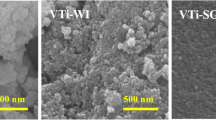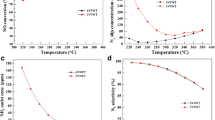Abstract
The synergetic abatement of multi-pollutants is one of the development trends of flue gas pollution control technology, which is still in the initial stage and facing many challenges. We developed a V2O5/TiO2 granular catalyst and established the kinetic model for the simultaneous removal of NO and chlorobenzene (i.e., an important precursor of dioxins). The granular catalyst synthesized using vanadyl acetylacetonate precursor showed good synergistic catalytic performance and stability. Although the SCR reaction of NO and the oxidation reaction of chlorobenzene mutually inhibited, the reaction order of each reaction was not considerably affected, and the pseudo-first-order reaction kinetics was still followed. The performance prediction of this work is of much value to the understanding and reasonable design of a catalytic system for multi-pollutants (i.e., NO and dioxins) emission control.

Similar content being viewed by others
References
Addink R, Olie K (1995). Mechanisms of formation and destruction of polychlorinated dibenzo-p-dioxins and dibenzofurans in heterogeneous systems. Environmental Science & Technology, 29(6): 1425–1435
Alemany L J, Lietti L, Ferlazzo N, Forzatti P, Busca G, Giamello E, Bregani F (1995). Reactivity and physicochemical characterization of V2O5-WO3/TiO2 De-NOx catalysts. Journal of Catalysis, 155(1): 117–130
Du C, Lu S, Wang Q, Buekens A G, Ni M, Debecker D P (2018). A review on catalytic oxidation of chloroaromatics from flue gas. Chemical Engineering Journal, 334: 519–544
Finocchio E, Busca G, Notaro M (2006a). A review of catalytic processes for the destruction of PCDD and PCDF from waste gases. Applied Catalysis B: Environmental, 62(1–2): 12–20
Forzatti P (2001). Present status and perspectives in de-NOx SCR catalysis. Applied Catalysis A, General, 222(1–2): 221–236
Gan L, Chen J, Peng Y, Yu J, Tran T, Li K, Wang D, Xu G, Li J (2018a). NOx removal over V2O5/WO3-TiO2 prepared by a grinding method: influence of the precursor on vanadium dispersion. Industrial & Engineering Chemistry Research, 57(1): 150–157
Gan L, Guo F, Yu J, Xu G (2016). Improved low-temperature activity of V2O5-WO3/TiO2 for denitration using different vanadium precursors. Catalysts, 6(2): 25
Gan L, Lei S, Yu J, Ma H, Yamamoto Y, Suzuki Y, Xu G, Zhang Z (2015). Development of highly active coated monolith SCR catalyst with strong abrasion resistance for low-temperature application. Frontiers of Environmental Science & Engineering, 9(6): 979–987
Gan L, Li K, Xiong S, Zhang Y, Chen J, Peng Y, Li J (2018b). MnOx-CeO2 catalysts for effective NOx reduction in the presence of chlorobenzene. Catalysis Communications, 117: 1–4
Gan L, Shi W, Li K, Chen J, Peng Y, Li J (2018c). Synergistic promotion effect between NOx and chlorobenzene removal on MnOx-CeO2 catalyst. ACS Applied Materials & Interfaces, 10(36): 30426–30432
Gan L, Wang Y, Chen J, Yan T, Li J, Crittenden J, Peng Y (2019). The synergistic mechanism of NOx and chlorobenzene degradation in municipal solid waste incinerators. Catalysis Science & Technology, 9(16): 4286–4292
Goemans M, Clarysse P, Joannès J, de Clercq P, Lenaerts S, Matthys K, Boels K (2003). Catalytic NOx reduction with simultaneous dioxin and furan oxidation. Chemosphere, 50(4): 489–497
Hashimoto Y, Uemichi Y, Ayame A (2005). Low-temperature hydro-dechlorination mechanism of chlorobenzenes over platinum-supported and palladium-supported alumina catalysts. Applied Catalysis A, General, 287(1): 89–97
Hutchings G J, Heneghan C S, Hudson I D, Taylor S H (1996). Uranium-oxide-based catalysts for the destruction of volatile chloro-organic compounds. Nature, 384(6607): 341–343
Kompio P G W A, Brückner A, Hipler F, Auer G, Löffler E, Grünert W (2012). A new view on the relations between tungsten and vanadium in V2O5-WO3/TiO2 catalysts for the selective reduction of NO with NH3. Journal of Catalysis, 286: 237–247
Krishnamoorthy S, Baker J P, Amiridis M D (1998). Catalytic oxidation of 1,2-dichlorobenzene over V2O5/TiO2-based catalysts. Catalysis Today, 40(1): 39–46
Kulkarni P S, Crespo J G, Afonso C A M (2008). Dioxins sources and current remediation technologies: A review. Environment International, 34(1): 139–153
Li J, He H, Hu C, Zhao J (2013). The abatement of major pollutants in air and water by environmental catalysis. Frontiers of Environmental Science & Engineering, 7(3): 302–325
Liu C, Chen L, Li J, Ma L, Arandiyan H, Du Y, Xu J, Hao J (2012). Enhancement of activity and sulfur resistance of CeO2 supported on TiO2-SiO2 for the selective catalytic reduction of NO by NH3. Environmental Science & Technology, 46(11): 6182–6189
Liu Y M, Cao Y, Yi N, Feng W L, Dai W L, Yan S R, He H Y, Fan K N (2004). Vanadium oxide supported on mesoporous SBA-15 as highly selective catalysts in the oxidative dehydrogenation of propane. Journal of Catalysis, 224(2): 417–428
Liu Z M, Li Y, Zhu T L, Su H, Zhu J Z (2014a). Selective catalytic reduction of NOx by NH3 over Mn-promoted V2O5/TiO2 catalyst. Industrial & Engineering Chemistry Research, 53(33): 12964–12970
Liu Z, Woo S I (2006). Recent advances in catalytic DeNOx science and technology. Catalysis Reviews. Science and Engineering, 48(1): 43–89
Liu Z M, Zhang S X, Li J H, Zhu J Z, Ma L L (2014b). Novel V2O5-CeO2/TiO2 catalyst with low vanadium loading for the selective catalytic reduction of NOx by NH3. Applied Catalysis B: Environmental, 158–159: 11–19
Peng Y, Chen J, Lu S, Huang J, Zhang M, Buekens A, Li X, Yan J (2016). Chlorophenols in municipal solid waste incineration: A review. Chemical Engineering Journal, 292: 398–414
Phil H H, Reddy M P, Kumar P A, Ju L K, Hyo J S (2008). SO2 resistant antimony promoted V2O5/TiO2 catalyst for NH3-SCR of NOx at low temperatures. Applied Catalysis B: Environmental, 78(3–4): 301–308
Reiche M, Maciejewski M, Baiker A (2000). Characterization by temperature programmed reduction. Catalysis Today, 56(4): 347–355
Roduit B, Wokaun A A, Baiker A (1998). Global kinetic modeling of reactions occurring during selective catalytic reduction of NO by NH3 over vanadia/titania-based catalysts. Industrial & Engineering Chemistry Research, 37(12): 4577–4590
Sui Z, Zhang Y, Peng Y, Norris P, Cao Y, Pan W P (2016). Fine particulate matter emission and size distribution characteristics in an ultra-low emission power plant. Fuel, 185: 863–871
Valdés-Solís T, Marbán G, Fuertes A B (2004). Kinetics and mechanism of low-temperature SCR of NOx with NH3 over vanadium oxide supported on carbon-ceramic cellular monoliths. Industrial & Engineering Chemistry Research, 43(10): 2349–2355
Wang C, Wang J, Wang J, Shen M (2021). Promotional effect of ion-exchanged K on the low-temperature hydrothermal stability of Cu/SAPO-34 and its synergic application with Fe/Beta catalysts. Frontiers of Environmental Science & Engineering, 15(2): 30
Wang J, Wang X, Liu X, Zeng J, Guo Y, Zhu T (2015). Kinetics and mechanism study on catalytic oxidation ofchlorobenzene overV2O5/TiO2 catalysts. Journal of Molecular Catalysis A Chemical, 402: 1–9
Willi R, Maciejewski M, Göbel U, Köppel R A, Baiker A (1997). Selective reduction of NO by NH3 over chromia on titania catalyst: investigation and modeling of the kinetic behavior. Journal of Catalysis, 166(2): 356–367
Wu S, Zhou J, Pan Y, Zhang J, Zhang L, Ohtsuka N, Motegi M, Yonemochi S, Oh K, Hosono S, Qian G (2016). Dioxin distribution characteristics and health risk assessment in different size particles of fly ash from MSWIs in China. Waste Management (New York, N.Y.), 50: 113–120
Yang J, Ma H, Yamamoto Y, Yu J, Xu G, Zhang Z, Suzuki Y (2013). SCR catalyst coated on low-cost monolith support for flue gas denitration of industrial furnaces. Chemical Engineering Journal, 230: 513–521
Yao H C, Yao Y F Y (1984). Ceria in automotive exhaust catalysts: I. Oxygen storage. Journal of Catalysis, 86(2): 254–265
Zhang K, Xu J, Huang Q, Zhou L, Fu Q, Duan Y, Xiu G (2020). Precursors and potential sources of ground-level ozone in suburban Shanghai. Frontiers of Environmental Science & Engineering, 14(6): 92
Zhang S, Li H, Zhong Q (2012). Promotional effect of F-doped V2O5-WO3/TiO2 catalyst for NH3-SCR of NO at low-temperature. Applied Catalysis A, General, 435–436: 156–162
Zhang S, Zhong Q, Zhao W, Li Y (2014). Surface characterization studies on F-doped V2O5/TiO2 catalyst for NO reduction with NH3 at low-temperature. Chemical Engineering Journal, 253: 207–216
Acknowledgements
We gratefully acknowledge the National Natural Science Foundation of China (Grant Nos. 21876093 and 21777081).
Author information
Authors and Affiliations
Corresponding authors
Additional information
Highlights
• AV2O5/TiO2 granular catalyst for simultaneous removal of NO and chlorobenzene.
• Catalyst synthesized by vanadyl acetylacetonate showed good activity and stability.
• The kinetic model was established and the synergetic activity was predicted.
• Both chlorobenzene oxidation and SCR of NO follow pseudo-first-order kinetics.
• The work is of much value to design of multi-pollutants emission control system.
Supporting Information
Rights and permissions
About this article
Cite this article
Gan, L., Li, K., Niu, H. et al. Simultaneous removal of NOx and chlorobenzene on V2O5/TiO2 granular catalyst: Kinetic study and performance prediction. Front. Environ. Sci. Eng. 15, 70 (2021). https://doi.org/10.1007/s11783-020-1363-5
Received:
Revised:
Accepted:
Published:
DOI: https://doi.org/10.1007/s11783-020-1363-5




